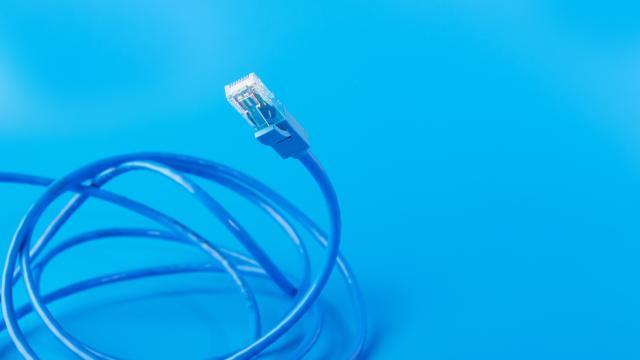I will confess something to you, dear reader: for the past three years, I’ve been using a 10-metre Ethernet cable with my gaming PC, running across my apartment from one room to the other (under a rug, of course). It’s not as bad as you think, and I’m writing about it to inspire you to do the same (if you need to).
When I bought the gigantic cable, my modem was massively underperforming. It was about 10 years old, and the Wi-Fi signal was dropping off within two metres. So, naturally, being a nerd who cares about internet speed and consistency, I opted for a long Ethernet cable to alleviate these issues.
I was worried about it not fixing my speed concerns and potentially getting in the way, but it’s been fine. Here’s what I’ve learned from the experience.
What is an Ethernet cable used for?
Let’s just quickly explain the purpose of these cords. Ethernet cords provide wired internet from a router to a computer, without the computer having to rely on Wi-Fi (and the speed-limiting factors unique to Wi-Fi). Because it’s a wired connection, it’s generally more reliable than its wireless counterpart, but this of course means that you’re dealing with the ugliness of a long cable running across your room.
Does a longer Ethernet cable affect speed?
A common misconception is that Ethernet cables, once they surpass the one-metre or three-metre length, drop off drastically in speed. It’s not true. As noted by New York Cables, CAT 6A Ethernet cables can maintain a usable speed while reaching up to 100 metres, as can older Ethernet cable types. Meanwhile, the newest Ethernet type (CAT 8A) can reach up to 30 metres and maintain a speed of 40,000Mbps. If you want some hands-on impressions from people who have long cables, LinusTechTips has a forum post here filled with people saying it’s fine for their setup. The bottom line is that as long as these cables are as long as they are recommended to be, your speed will be fine.
Speaking from my own experience, as someone who uses an NBN 100 internet plan (with 100Mbps download speeds) and a 10-metre CAT 6A cable, my speeds rarely dip below 97Mbps. Meanwhile, a Wi-Fi speed test from the same distance yields speeds results at the same mark, but bounces between 85Mbps and 97Mbps more. As I live in an apartment with a lot of gadgets on my home connection, there’s more Wi-Fi noise, which is having an impact on network consistency, so this makes sense.
It’s not until you start surpassing the hundred-metre mark that speed issues start to become noticeable. That being said, with a maximum speed capability of 10,000Mbps on CAT 6A, you’re unlikely to really notice a tremendous speed drop beyond the 100-metre point, with Australian internet speeds well below 10,000Mbps.
So, for most home users, it doesn’t matter all that much. If you’re attempting to service a computer or networking system across a long distance (say, for example, on a farm or in a factory), you may run into some issues.
Are long Ethernet cables a tripping hazard?
The hardest part about having such a big Ethernet cable is that you’re likely to trip on it. Ethernet cables are thick and if not properly positioned, can be a serious hazard.
There are a few solutions to this. Ideally, if you’re using the full length of the available, it’ll be tensioned enough so that there’s no catch and doesn’t gather anywhere where people walk. This may pose a tripping hazard if it runs across your house in an unideal way (for example, needing to run across the middle of rooms), but you can safely put a thick rug on top of the cable to minimise tripping potential.
It’s also a good idea to run the cable across the edges of the rooms it passes through. If in this case, you have some of the cable left over, you can gather the cable’s excess and duck it behind furniture to minimise tripping and make your apartment just look nicer. It’s not a particularly good idea to use tape to fix Ethernet cables to the edges of a room, as this can rip the paint. Rather, it’s better to use Ethernet cable covers.
Additionally, if you own the property, you can modify walls to allow for a cable to pass through without going through any potential walkways, but this requires quite a bit of effort and planning – as would moving the entire internet connection port in your wall, if you don’t want ugly cables at all.
How much do Ethernet cables cost?
Ethernet cables aren’t expensive at all. On Amazon, a fairly standard three-metre CAT6 Ethernet cable costs about $9, while a 10-metre cable will set you back $16.
If you’ve been dealing with a finicky Wi-Fi connection, then it’s definitely worthwhile trying out a wired Ethernet solution.
Image: iStock
This article has been updated since it was originally published.
